
Newsletter of the Shell Club of Sydney
NSW Branch, The Malacological Society of Australasia Limited ACN 067 894 848
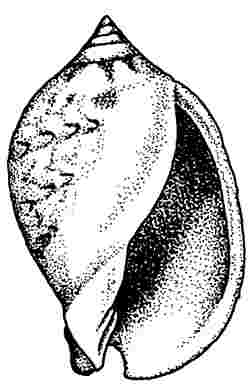
Phallum Labiatum
Sept. 98 meeting presentation:
The Karen Wadwell & Chris Barnes Tassie Trip
November/ December 1997
Before the trip we decided to do a little research to make sure we didn't miss the best shelling spots and had our itinerary prepared correctly ( ie. make looking for shells a priority!).
We contacted well known shell author and retired school teacher, Margaret Richmond. We called Margaret and made arrangements to visit her when we reached Devonport.
Unfortunately I had already organised the itinerary with the travel agent. There were trips to wildlife parks, wineries, shopping areas and places of cultural interest planned and finally at the end of our trip we would be in Devonport, much to Chris' disgust!
Oh well... we landed in Melbourne on a 40 0C day and changed to a smaller plane for the flight to Launceston. On arrival our plan was to travel to Bicheno on the East coast via Scottsdale and hopefully see some coast on the way. Time restraints meant that we only saw a little of the beach north of Bicheno as Tassie closes down at 7.30pm so we had to reach our accommodation and have dinner before the restaurants closed.
We tried to observe the penguins purported to walk up the beach near our cabin later that night, but their clock wasn't synchronised with ours and we missed them. We did hear them going back into the water at 4.30am however!
Next day we woke to a grey wet morning, a definite contrast from the previous day. We were soon to get used to the Four seasons in one day theme. We did try to seek out some shells but to no avail.
Instead we visited Freycinet Vineyard and sampled the excellent wines; just the thing to see us through the rest of our arduous day!
We travelled on to Coles Bay and admired the beautiful, if damp, scenery. Again, shelling was limited and uneventful.
The next day saw us travelling to Port Arthur via Richmond, where we photographed the bridge (Australia's oldest) and partook of a wonderful old fashioned morning tea (with Passionfruit sponge cake).
Port Arthur was interesting but subdued and we spent the afternoon scouring the Tessellated Pavement for shells. Here we had some luck, finding a specimen of
Fusus reticulatus (Adams, 1855). On to Hobart, where we didn't do any shell collecting but managed visits to the fabulous Salamanca Markets (terrific wood products, arts, crafts and fresh produce), the Tasmanian Distillery and a trip to the top of a very windy and cold Mount Wellington.
We also paid a visit to Bruny Island. A car ferry leaves several times a day from Kettering. Again we were disappointed by the lack of shells [though we did find a
Mytilus edulis planulatus (Lamarck, 1819) with a pearl in it] but we visited the historic Bligh Museum and had another lovely morning tea at Adventure Bay.
We returned to the mainland midafternoon and took a circuitous route back to Hobart through Cygnet and Huonville.
Leaving Hobart the following day we travelled to the Cadbury Factory at Claremont where we toured through, filling up on yummy chocolates. We finally staggered out after spending much time and money stocking up in the shop!
On we went to Strahan via Queenstown. As this route was inland, there was no opportunity for shell collecting but we bought a lovely Huon Pine coffee table on the way and admired the fabulous Wild Rivers scenery.
Arriving in Strahan we booked on a Gordon/ Franklin river cruise. The day was wet and cool but while under way the sun obligingly made brief appearances at the most appropriate times. Macquarie Harbour and the Hells Gates were spectacular.
The trip to Sarah Island was unforgettable due to the Historian and local Thespian who conducted a walking tour of this historic convict site.
We left Strahan for Cradle Mountain where we admired the spectacular view but as there were no shells to be seen we continued to Devonport and our appointment with Margaret.
Over afternoon tea, Margaret very kindly explained how to access her personal collecting sites. We met her cats (she dedicated her second shell book to Thomas, sadly deceased) and chatted about her shells and other prized possessions. Margaret is a lovely person, full of enthusiasm for shells and collecting but is restricted in her activities by arthritis. She still loves to have a chat and is keen to meet other shellers and discuss her hobby.
Finally we did some serious shell collecting at Anthony's Beach (Perkins Bay) west of The Nut at Stanley and found some good specimens. Eg-
Calliostoma armilliatum (Wood, 1828)
Cancellaria granosa Sowerby, 1832
Clanculus undatus (Lamarck, 1816)
Phasianella australis (Gmelin, 1791)
We toured the lovely wineries on the Tamar River near Launceston and spent a couple of days there before flying to King Island.
This magical jewel of an island in Bass Strait was to be the site of the best shell collecting of the entire trip. The scenery was breathtaking and the fabulous dairy produce was almost worth the trip alone.
The owner of the villa we stayed in went out of his way to see that we enjoyed our stay and got to see all the sights. He also organised an excursion to Grassy Harbour near the old Scheelite (tungsten) mine to view the Little Penguins returning home at dusk. This was very successful as over two hundred hopped over rocks within centimetres of us. At the same time Mutton birds swooped over head, returning to their burrows also.
The best shelling was to be found at Naracoopa Beach on the east side of the island. Among the debris of seaweed etc were some fine shell specimens just waiting to be picked out of the flotsam and jetsam of the high tide mark. Eg-
Astele subcarinatum (Swainson, 1854) and
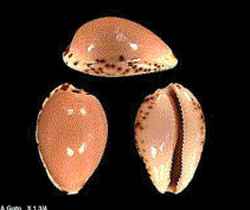
Cypraea angustata Gmelin, 1791
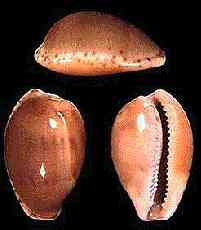
Cypraea comptoni Gray, 1847
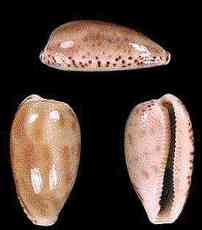
Cypraea piperita Gray, 1825 and
Clanculus limbatus (Quoy & Gaimard, 1834)
Sassia eburnea (Reeve, 1844)
Sassia verrucosa (Reeve, 1844)
Sadly our stay on King Island was way too short and we headed home vowing to return one day for a much longer
visit
Book Review
Indo-West Pacific Ranellidae, Bursidae and Personidae
(Mollusca: Gastropoda)
A monograph of the New Caledonian fauna and revisions of related taxa
by Alan G. Beu
Mémoires du Muséum National d'Histoire Naturelle Vol. 178, Résultats des Campagnes MUSORSTROM 19
October 1998, 255 p., hard cover, 70 plates, 4 colour plates, 220 x 277 mm, ISBN 2 85653 517 8
A rather daunting title adorns this very new publication, volume 178 of the
Memoirs of the French Natural History Museum in Paris, or vol. 19 of the
MUSORSTROM project, which describes many aspects of the sea life around the French colony of New Caledonia. Add to this Alan Beu, a New Zealander, who is considered the world leading expert on Ranellidae, Bursidae and Personidae, and the only French you will see in this book is in the Summary.
This a scientific publication that is most interesting to collectors of this family. Alan describes seventy-three species from more than 1000 collecting stations around New Caledonia, the Loyalty Islands, Coral Sea and New Hebrides Archipelago. He re-arranges a few genera, illustrates a lot of type material and describes a few new species. Of course most of the
species in the Ranellidae, Bursidae and Personidae have very wide distribution ranges and thus many species described here can be found in the entire Indo-Pacific region, and even beyond.
As in scientific publications, the species are described in the finest detail, with information on the whereabouts of type material included.
There is a very useful "remarks" section for each species, where the comparisons are made, and past taxonomy discussed. Of course a full
synonymy is given as well.
Surprisingly for a scientific text, there is no information on the living
animal, or the radula. All descriptions are based on shell characters alone. I think this is a pity because many Ranellids have interesting
habits and brightly coloured animals. Even if this type of information was
considered outside the scope of the book, I feel that there should have been an explanation as to why this was done.
Each species is profusely illustrated. There are 70 (!) plates, four of which are in colour; the rest are in black and white, but all are of outstanding quality. The smaller species and protoconchs are illustrated with SEM photographs.
At the end of the book there is a list of references longer than I have ever seen in a work like this. There is also an index, and a list with exact localities of the collecting stations.
The book is in hard cover and looks quite pretty. Some may find the type
rather small, but this, too, is typical for scientific publications.
It is not a book for beginners, but collectors of Ranellidae, Personidae
and Bursidae, and those interested in the larger shells of the Indo-Pacific
region will find this an invaluable publication to add to their library.
Minutes November 1998
The meeting was opened by D. Beechey at 2.01pm. Des extended a warm welcome to Keith Dean and Noel & Maureen Anderson.
Apologies were received from I. Myers, E. Uhle, F. McCamley and standing apologies.
New Shell Acquisitions A. Miskelly reported on some great finds from around Sydney. Ashley collected
Cassis thomsoni (Brazier, 1875) dived at La Perouse, Botany Bay. A specimen of
Cypraea xanthadon Sowerby, 1822
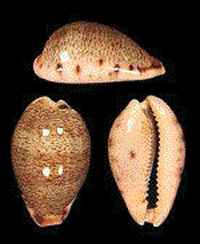
and a near perfect specimen of Chicoreus denudatus (Perry, 1811) were dived off Vaucluse, Sydney Harbour.
R. Moylan reported on some new shells acquired from New Caledonia, including:
Conus lienardi Bernardi & Crosse, 1861, which is endemic to the region.
New Items P. Jansen gave an impromptu review of a monograph by Alan Beu titled Indo West Pacific Ranellidae, Bursidae & Personidae. Patty described the book as scientific.
The work is priced at $125.00.
S. Clark reported on a PhD study by Tan form Singapore. The study included Muricidae and Thaidinae, their distribution across Northern Australia from Port Hedland to Darwin. The study considered characteristics such as egg shape, size and morphology.
Field Trip Reports M. Keats reported on a brief working trip to Tasmania. He visited Eagle Hawk Neck and beach collected some 200 shell species. Michael also mentioned his good fortune at being able to acquire a Collection of some 500 species from Trigs Beach at Scarborough (near Perth) in W. A, that had been collected over a number of years with the aid of mixed currents.
C. Barnes reported on a visit to Lennox Head on the NSW north coast, where he collected a number of Cypraeidae species. Chris also mentioned that Little Bay in Sydney was a productive spot for shellers much closer to home.
R. Moylan discussed the proposed Solomon Islands trip ( August - September??) reporting that airfares Syd/Bris/Honiora were $961.40 pp return. Ron said that there would be room for approximately 8-10 people in the accommodation he currently had under way.
General Business K. Wadwell reported that she had contacted Dr Peter Duncan (editor Australian Shell News) to keep abreast of branch happenings.
It was decided after some discussion and a vote to hold the annual Christmas meeting at Yarra Bay, as explained below.
A decision on our new meeting place was finally made after a lengthy discussion and a show of hands. The options were Ryde Eastwood Leagues Club, The Australian Museum and the Baptist Church Hall at Mosman. The decision was made in favour of RELC (9/3/1) as expenses and parking availability were a major consideration.
Letter from Con Moutoudis, sending his best wishes.
M. Keats reported that Fisheries are decentralising their operations. Cronulla will remain Head Office and there will be various field centres, at places like Port Stephens.
The Common Seashells of Sydney poster is being advertised in their newsletter.
It was reported that the Melbourne Shell Show is being held over the weekend of the
24th, 25th and 26th of April 1999.
Presentations M. Keats gave a presentation on the Family Bursidae, using diagrams and drawings on the overhead projector.
Next Meeting Field trip to Yarra Bay (Botany Bay) then on to Little Bay (via Prince Henry Hospital) Saturday 12 December, at 12 noon.
Meeting closed at 3.28pm.
C. Barnes, Secretary
Guess what shell this is?
(The common name relates to cats)
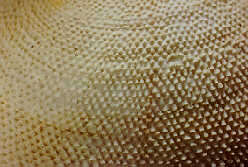
The 1998 Christmas Picnic to Yarra Bay and Little Bay
By Chris Barnes
The picnic day 12/12/1998 at 12:00 noon was selected by vote at the previous monthly meeting; the tide timing was completely inappropriate for shell collecting (a matter which I can only accept half the blame). Despite this, it was a great day for a picnic, the sun was shining and the birds were singing though it was a little breezy.
The plan was to meet at Yarra Bay for a picnic and then head over to Little Bay to explore and examine the local mollusc population.
Karen and myself met Michael and Jenny Keats first and we took up a position at one of the covered bench tables. Patty Jansen and daughters were next to appear, followed closely by Steve, Vicky and their son.
Once lunch was completed and a few of our party had explored and paddled in Yarra Bay, it was decided to head over to Little Bay for more of the same and to see if any others had turned up there. On arrival we met Ashley Miskelly and Ernie Uhle with a young diving friend. They had been diving at La Perouse earlier in the day and had a number of unusual shell specimens to show the group. Stephanie Clark also arrived just in time to assist in identifying some of the day's more interesting finds.
Although the tide was not conducive to collecting, the weather was great
and a number of people braved the surf. Steve's son was stung by a "Blue Bottle". Ashley came to the rescue with some ointment and all was well again.
By about 3.30pm everyone had had enough for the day and it was time to head home. A couple of people suggested to me that Little Bay was quite beautiful and with an appropriate tide would be a good shelling spot.
Shell guess answer: Tellina linguafelis (cat's tongue)
|






